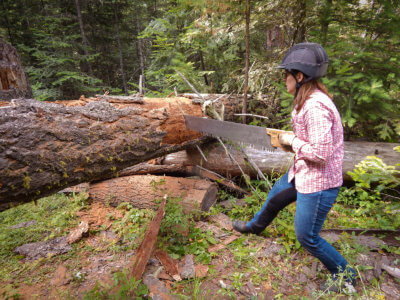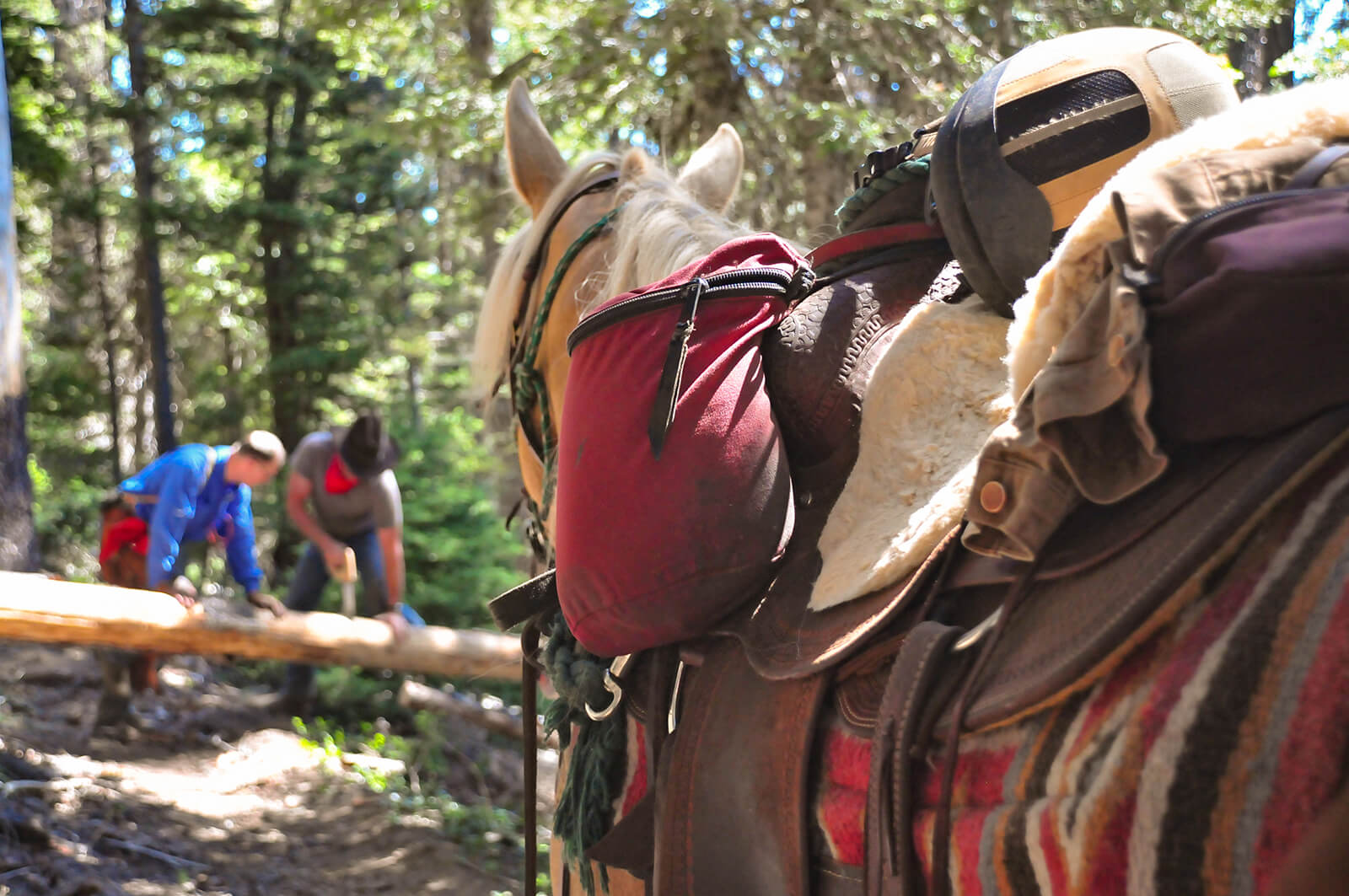Trees happen, and they occasionally fall. It’s better to have a saw than have to turn around.
Most often you can step over or ride around fallen limbs and downed trunks. Just as often it’s not safe to do so. When windfall blocks the trail not only is it sometimes impossible to ride around the obstacle, it’s also not a good habit to get into. Riding around a barrier, instead of removing it, leads to many user paths weaving through an area causing further erosion, mud, and other issues.
It’s better to clear the trail. You wanted to stretch, and your horse wants a quick break too. Clearing trails is a good practice to foster. You’re helping your fellow trail users and land managers, as well as promoting riders as responsible trail users.
What Type of Saw?
There are many types of saws readily available. We’re going to stick with the following manual types: pocket chainsaws, folding saws, and fixed-blade saws.
Pocket chainsaws
This handy survival tool consists of chainsaw blades with handles at both ends that allow the operator to cut through branches. Unlike their much heavier battery-powered and gas-powered cousins, a pocket chainsaw weighs less than half a pound and fits in a small case that can easily be carried in your saddlebags.
Folding saws
Folding saws are designed to give you the cutting ability of a fixed blade saw but in a lightweight design that is safe to carry in your saddlebags. Blades of these saws have an aggressive set of teeth that are safely out of harm’s way once folded into the built-in sheath.
Fixed blade saws
Fixed blade or rigid handle saws are heavier and slightly harder to pack than the types previously mentioned. But they work better and are much sturdier. Cutting through downfall is work; why make it any harder? A fixed blade saw in a sturdy sheath will ride nearly unnoticed under your saddle’s fenders.
How Big?
 Size matters. Yes, it does. The largest cut you can make with a saw depends on the length of the blade. For an efficient cutting action, you want plenty of travel on each stroke. In theory, an 18-inch blade can get through a 17-inch log but you’ll be making plenty of tiny push-pull movements and it’s going to take forever. As a guide, if you’re looking to cut up to 6-inch logs then a blade of 10 to 12 inches is fine.
Size matters. Yes, it does. The largest cut you can make with a saw depends on the length of the blade. For an efficient cutting action, you want plenty of travel on each stroke. In theory, an 18-inch blade can get through a 17-inch log but you’ll be making plenty of tiny push-pull movements and it’s going to take forever. As a guide, if you’re looking to cut up to 6-inch logs then a blade of 10 to 12 inches is fine.
For most of us, the choice between a pocket chainsaw, folding saw, or fixed blade will come down to how often you’re going to use it. Do you want a “just in case” saw or do you want to be prepared for whatever nature throws at you?
I don’t know what it’s like in your part of the world, but in the Pacific Northwest riders can always find blowdown across the trail. And the next time the wind blows there will be even more. I don’t leave the trailhead without a sturdy fixed blade saw. Often, it’s “Little Joe” — a 20-inch saddle saw. If I’m going on a longer ride or pack trip I bring “Stella,” my 40-inch crosscut which rides under my fenders.
What to Look For
Whichever type of saw you choose here are a few considerations worth noting:
- Sharpness – It doesn’t matter how great the rest of the saw is, if the blade isn’t sharp, you’re going to have a tough time. The best blades not only start sharp but are tempered and coated so they stay sharp. In this aspect, name brands are more than marketing hype. Silky and similar brands all make sharp blades.
- Cutting efficiency – How much wood is removed with each stroke? Cutting efficiency depends on a combination of elements such as blade length, sharpness, and cutting teeth design. Some blades only cut on the pull stroke while others cut on both.
- Handle – you want an ergonomic handle design that sits comfortably in the hand, including when you are wearing gloves.
- Safety – Sharp saw blades will cut more than wood. Make sure you have a way of keeping the blade safe so it only cuts when you want it to.
- Lightweight – You want a saw that’s easy to carry, but reduced weight sometimes means reduced overall structural integrity. Saws with shorter blades and polymer handles and frames (rather than metal) may save you a few ounces.
- Versatility – Don’t look for a Swiss Army knife-type solution in a saw. Look for a saw that will cut wood and do it well.
- Sharpening or replacing blades – Make sure the saw you buy can be sharpened or uses a blade that can be replaced. The cost of some replacement blades sometimes gets close to the cost of a new saw.
Not all saws are equal, so it pays to spend a little extra to buy a well-made product. The best saw, regardless of type, will have a sharp, quality blade.
Look for design elements that will improve the efficiency of your cutting strokes, so you can go through more obstacles with less work. Weight is always a concern but don’t be too quick to discount the benefits of carrying that heavier saw. Some type of saw is a must-have for every serious trail rider. I carry one and everyone that I ride with does so as well.
At some point, you’re going to encounter a log, a blowdown, or a tree with branches pointing in every direction that you cannot easily go over or around. By carrying a saw you’ll be able to clear the path and be back on your way in short order.
As always for more information on trail riding and horse camping, as well as the world’s largest and most comprehensive guide to horse trails and camps, visit us at www.TrailMeister.com
See this article in the October 2021 online edition:

Robert Eversole, ”the trail meister,” owns www.TrailMeister.com, the largest database of horse riding and camping areas in the U.S. with free trail and trailhead information, trail maps, and much more to help horse enthusiasts experience the joys of trail riding. Robert is a registered riding instructor with PATH International, a mounted search and rescue team member, and a U.S. Marine who has served on the board of the Backcountry Horsemen of Washington (BCHW). He is enjoying his new career helping fellow trail riders stay found and safe on the trail. When not on the trail, The Trail Meister resides near Spokane, WA and teaches land navigation to a wide variety of outdoor groups across the nation. For North America’s largest horse trail and camping directory, trail tips, and more, visit www.TrailMeister.com.






